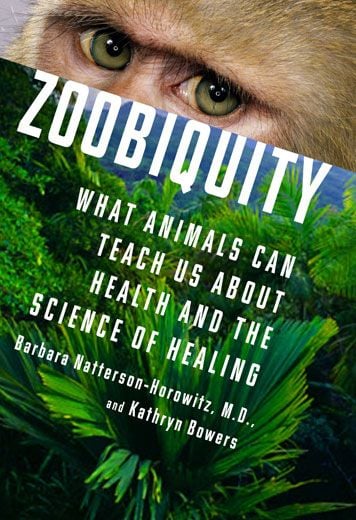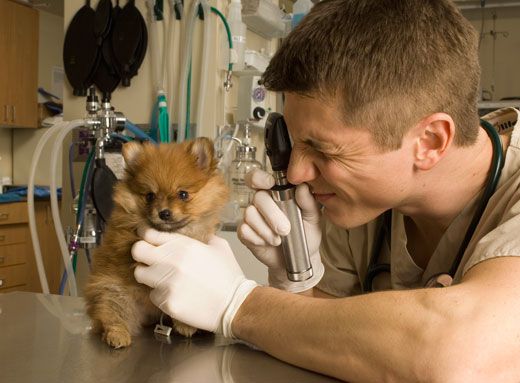How Looking to Animals Can Improve Human Medicine
In a new book, UCLA cardiologist Barbara Natterson-Horowitz reminds us that humans are animals too. Now, if only other doctors could think that way
/https://tf-cmsv2-smithsonianmag-media.s3.amazonaws.com/filer/Corbis-VetPuppy-631.jpg)
If humans and animals experience some of the same injuries, diseases and disorders (and they do), then why don’t doctors more often seek the advice of veterinarians and animal experts?
It is a good question, and one that Barbara Natterson-Horowitz asks in her new book, Zoobiquity, co-authored by Kathryn Bowers.
A cardiologist at the UCLA Medical Center, Natterson-Horowitz serves on the medical advisory board of the Los Angeles Zoo. In this role, she is occasionally called on to help examine chimpanzees, gorillas, orangutans and other exotic animals with heart conditions. When Cookie, a lioness at the Zoo, for instance, developed pericardial tamponade, or a build-up of fluid in the sac around its heart, Natterson-Horowitz helped a team of veterinarians, veterinary surgeons and cardiothoracic anesthesiologists drain it. She used the same procedure she would for a human patient.
According to the cardiologist, the fact that human doctors do not reciprocate by seeking the expertise of veterinarians and comparing their patients’ cases with those of animals is a “major blind spot.”
“Engineers already seek inspiration from the natural world, a field called biomimetics,” says Natterson-Horowitz. “Now it’s medicine’s turn.”
What is zoobiquity?
Zoobiquity is the fusion of evolutionary biology and veterinary science with human medicine. Kathyrn Bowers (my co-author) and I are bringing together two cultures, animal medicine and human medicine, so we wanted to coin a word that brought together two cultures. We brought together zo, which is a Greek word for “animal” and ubique, which is Latin for “everywhere.”
When did it first become apparent to you that doctors and veterinarians should work together?
In 2004, I began spending time with veterinarians on rounds at Los Angeles Zoo, watching them take care of their patients, and I realized that there is a parallel universe of medical practice, of which many physicians are fairly unaware. That led to a very broad, open-minded question about how extensive the overlaps are in the critical syndromes of animals and humans.
So, what are some of those afflictions that humans and other animals have in common?
It is very hard to surprise me anymore, because I pretty much assume that nothing is uniquely human. Hypertrophic cardiomyopathy, the heart muscle problem that sometimes sadly results in the death of a high school athlete, occurs in a number of animal species. Similarly, some exotic animals seem to be predisposed to breast cancer. Jaguars, tigers and lions seem to have an elevated incidence of breast cancer and ovarian cancer.
We were really interested in obesity. Companion animals are getting fatter. Some felines are put on a high protein, low carb diet that veterinarians call the “Catkins” diet. Obese dogs occasionally get liposuction, and in some zoos around the country, animals are put on a Weight Watchers points-type system. Maybe it’s less surprising that the animals under our care are getting heavier, because we are as humans. But we asked, do wild animals get fat? We learned a lot about some animal populations that do indeed seem to be getting fatter, but also the natural cycle of fattening and thinning in the wild. There are many takeaways for human patients who are struggling with weight.
We looked at substance seeking or addiction. Do animals ever seek substances to alter their sensory states [much like humans seek out drugs or alcohol]? Bighorn sheep will scale very steep cliffs to get access to this psychoactive lichen that grows on the rocks. They grind down their teeth to get it onto their gums. Waxwing birds are notorious for ingesting fermented berries and flying while intoxicated. Then, some domestic dogs seek out wild toads to lick the hallucinogenic chemicals off their skin.
We are more alike than we sometimes think, right?
When I was going through my education, undergraduate and graduate school and med school, we were given very stern warnings against the tantalizing pull to anthropomorphize. Back then, if you saw a behavior or a facial expression on an animal and gave it a human characteristic you risked being viewed as unscientific and sentimental. You are just projecting.
But that is already a few decades ago, and there have been a lot of advances in neuroscience, molecular biology and comparative genomics. It is time that we update that view. I think we haven’t embraced our animal natures enough. When we do see similarities, we need to maintain scientific skepticism, of course. But we can also expand our view a little bit and consider what is anthropomorphizing and what might actually be recognizing a shared evolutionary legacy.
One of the arcs of the Zoobiquity story is to acknowledge our own ignorance and to then turn on the lights—to say wait a minute, let’s look at this. We are linked by evolution. We are linked through environment. We share the vast majority of our DNA with other animals, certainly with mammals but also with reptiles and even fish. So, is it really surprising that the clinical syndromes of animals and humans are the same? We’ve found that people catch on pretty quickly.
What are the benefits of a zoobiquitous approach?
When I was a psychiatrist I took care of a number of human patients who injured themselves. Psychiatrists sometimes call this behavior “cutting.” Until I wrote Zoobiquity, I assumed that this was a uniquely human behavior. I subsequently learned that self-injury is seen in quite a spectrum of different animal species. Horses, when they are stressed, isolated or bored, can engage in a behavior called flank biting. It is serious and can cause significant injury to the horses. Veterinarians have some very specific ideas about what triggers self-injury and importantly some very specific and highly effective ways of helping the animal decrease the behavior.
It was fascinating to learn that there is a syndrome in pigs called thin sow syndrome. Occasionally, a pig that is under social stress will decrease food consumption and start to lose weight. For females, the syndrome can also be associated with the animal not going into estrus, which is an interesting potential analog to what happens in some human anorexic females. They will stop menstruating. In some instances, the pigs will actually go on to starve themselves. Interestingly, farmers have specific ways of identifying risk factors for the syndrome and specific interventions. I think that would be the kind of information psychiatrists and psychotherapists would be interested in having.
The real challenge is to create bridges and to put this knowledge and these kinds of practices so well known and understood on the veterinary side into the hands of human practitioners.
Is there an example you can point out of a human treatment that was laying dormant in animal research?
There is this story I tell of sitting around the table at the Princeton Club in 1999. There was a veterinary oncologist named Phil Bergman. Next to him was Jedd Wolchok, at that time a rising star at Memorial Sloan-Kettering, one of the leading cancer research hospitals in the world. At one point during the dinner, Wolchok turned to Bergman and said, “Do dogs get melanoma?” That was really the right question asked to the right person at the right moment because Bergman happened to be one of the world’s experts in how malignant melanoma affects dogs.
The two of them began collaborating. Wolchok was already working on a novel therapy that would trick a patient’s immune system into attacking its own cancer. They had some early success, but they needed to know how the remedy might fare in animals with spontaneously occurring tumors. Within three months, Bergman had this trial up and going. He recruited nine dogs: a Siberian husky, a Lhasa Apso, a Bichon Frise, a couple of cocker spaniels and some other dogs. They all had various stages of melanoma, and they used this therapy, which involved injecting human DNA into dogs’ thigh muscles. It worked even better than Bergman and Wolchok expected. The dogs’ tumors shrank and their survival rates soared. Ultimately, this therapy was used in over 300 pet dogs. The translational potential, or the possibility of bringing that intervention over to the human side, is real. Bergman and Wolchok’s collaboration has now inspired work on a similar vaccine for melanoma in humans.
At this point, how much collaboration between doctors and vets are you seeing?
In the 25 years that I have been a physician, I can’t remember a single instance where we were discussing a patient and another physician on rounds brought up an animal patient with the same disorder.
If you ask physicians where the intersection between animal and human health is, most of them will probably first point to something called zoonoses. Zoonoses are diseases that travel between animals and humans. Without a doubt, zoonoses are very important to know about from the perspective of human health. Many of the emerging infections that pose pandemic threats to human populations do come from the animal reservoir—H1N1, SARS, West Nile virus, etc. But I really feel that to engage physicians—rank and file, clinical physicians, people like myself, cardiologists, gastroenterologists, gynecologists, pediatricians, people who see patients—in this discussion with veterinary medicine, we need to begin educating them about diseases that are not explicitly infectious diseases.
There is something called One Health, which has been emerging over the past ten years or so. It is an attempt to bring the fields together. It has primarily been led on the veterinary side. Veterinarians recognize the importance of animal health to human health. Unfortunately, that message has not really yet resonated loudly on the human side. I am hoping that Zoobiquity changes that.
Human medicine and veterinary medicine haven’t always been so siloed or separated, right? When did this change, and what caused it?
A hundred years ago animals played more of a part in humans’ lives. Certainly on farms that has always been the case, but even in urban areas, until the turn of the century, horses and oxen and other transportation animals played important roles. With the emergence of the combustion engine, automobiles entered cities and displaced some of the animals as transportation. Around that period, as a result of the Morrill Land-Grant Acts, veterinary schools were founded in agrarian communities whereas medical schools were placed in more urban areas. That geographical separation played a significant role in the siloing of our two professions.
You have started an annual Zoobiquity conference to facilitate relationships between doctors and veterinarians.
In January 2011, we had a conference where top veterinary academics from UC Davis School of Veterinary Medicine and top human academics from the UCLA School of Medicine discussed the shared diseases of different species. We had a case of a brain tumor, something called a glioblastoma, in a high school principal, which was presented by a human neuro-oncologist. Then we had a case of a glioblastoma in a Rhodesian Ridgeback, a dog, presented by a veterinary oncologist. We showed the CAT scans and discussed treatment. We did the same thing for heart disease, separation anxiety and OCD.
We also needed to literally build relationships, so, we all got on buses and drove to the Los Angeles Zoo. Veterinary cardiologists and human cardiologists met each other. Veterinary oncologists and human oncologists met each other. We had many medical students and veterinary students who also met each other. Then we went and walked rounds at the Zoo. That was intended to be both functional and symbolic.
We are doing a similar conference in September. We are covering breast cancer in different species and infertility and assisted reproductive technologies. We have a very prominent veterinarian from the Smithsonian Conservation Biology Institute, Pierre Comizzoli, coming out to present on advanced assisted reproductive technologies for endangered species, such as pandas. Then we are going to have a very prominent human fertility expert talk about the same techniques and challenges in a 40-year-old woman. We are doing bullying as well, looking with a very prominent human bullying expert at animal analogs of bullying behaviors. Then we are doing self-injury. The conference has been a physical, real-time, boots-on-the-ground effort to bring veterinarians and physicians closer to each other, particularly to allow physicians to recognize their clinical peers on the other side of the species divide.
How has this idea of zoobiquity changed the way you practice medicine?
Working with veterinarians has definitely made me a better physician. I think comparatively all of the time now. No matter what problem I encounter in a human patient, I immediately think about other animals with the same diseases. I think I have learned to be a better observer of my patients. Veterinarians don’t have language to use. Their patients can’t tell them what’s going on so they rely on physical diagnosis, inspection and observation, which are unfortunately becoming lost arts on the human side.
This interview series focuses on big thinkers. Without knowing whom I will interview next, only that he or she will be a big thinker in their field, what question do you have for my next interview subject?
That’s an easy one for me. I have two questions. If you were to bring into the conversation of whatever you are studying a related field that does not traditionally intersect with your own, what field might that be? And, in what ways can infusing evolutionary biology into your question, area or research, expand your perspective?
From my last interviewee, Robert W. Merry, a political journalist and author of Where They Stand, about the ranking of presidents: Why is the country in such a deadlock? And how are we going to get out of the crisis that is a result of that deadlock?
This idea of ranking really resonates with me. It has been over 150 years since Darwin showed us that we humans don’t sit on top of a pyramid of species. We are sitting on one branch of the tree of life. I think one thing that will help is for us to step off our pyramids. In my book, I argue that physicians should step off of the professional pyramid and see other health professionals as peers. In general, I think that the idea that there needs to be a hierarchy can be destructive and can actually get in the way of the collaborative problem solving that we need.
/https://tf-cmsv2-smithsonianmag-media.s3.amazonaws.com/accounts/headshot/megan.png)



/https://tf-cmsv2-smithsonianmag-media.s3.amazonaws.com/accounts/headshot/megan.png)